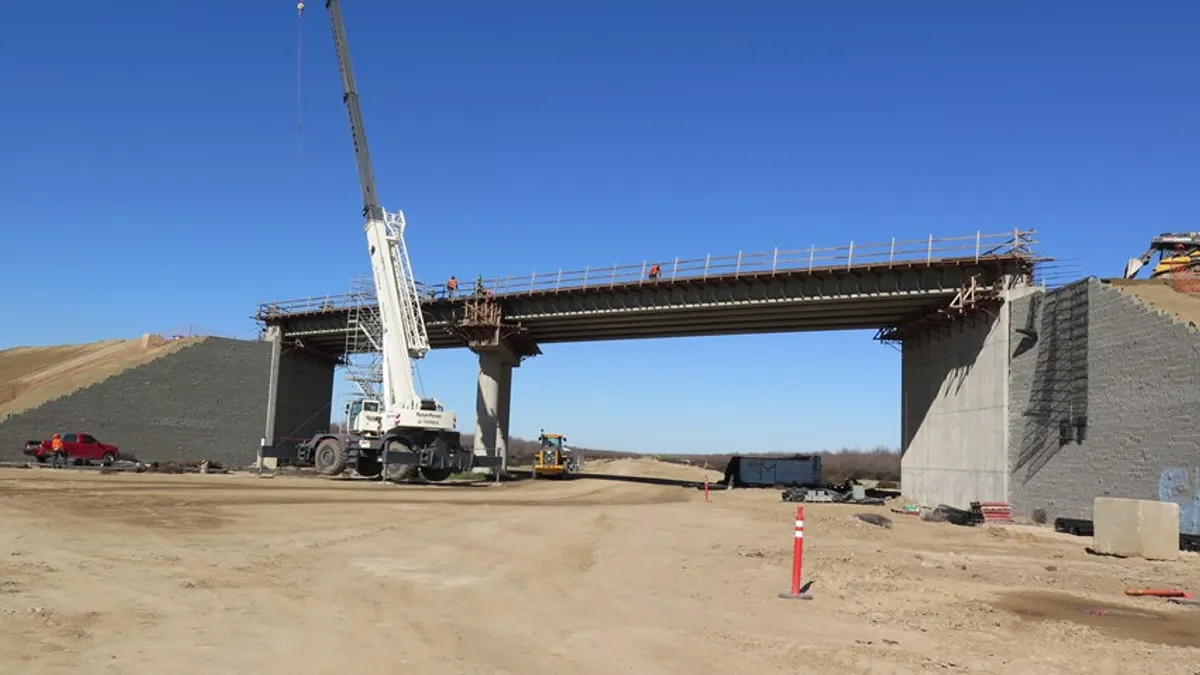Dive Brief:
- Total construction starts sank 7% from June to July, pulled down by a staggering 31% decline in the nonbuilding sector, which includes infrastructure projects, while the nonresidential sector gained 3% and residential starts increased 2%, according to Dodge Data & Analytics.
- Through the first seven months of 2020, total construction starts were down 15% as compared to the same period in 2019. Nonresidential construction starts plummeted 25% through July, and nonbuilding starts dropped by 20% compared to the same point last year, the firm said.
- Richard Branch, chief economist for Dodge, said the numbers weren’t all bad news. “The July decline in construction starts should not be interpreted as a setback on the sector’s road to recovery,” Branch said in a statement. “The gains in the nonresidential and residential sectors mirror the general overall improvements in the economy. The drop in public works could represent a settling back in activity following a solid spring in which some projects broke ground earlier than expected to take advantage of the fewer cars on the road during the COVID-19 shutdown in March and April.”
Brief insight
Anirban Basu, chief economist for Associated Builders and Contractors, said the new results reflected a number of impediments that have materialized for construction this summer that are likely to last for some time.
"The Dodge construction starts data indicate that tighter credit conditions, challenged state and local government finances and profound levels of economic uncertainty have already begun to negatively impact construction spending," Basu said. "Unfortunately, circumstances facing the average contractor are likely to deteriorate further as the pandemic lingers and as complete economic recovery proves elusive."
These challenges were reflected in the association's most recent Construction Confidence Index, with contractor confidence dwindling in July.
A federal stimulus package will help alleviate the crisis, but "commercial real estate fundamentals are likely to remain in poor shape for many years to come," Basu said.
The plummeting numbers in the nonbuilding segment, which includes roads and bridges as well as utilities and pipelines, were reported after road builders voiced concern this month about infrastructure projects worth $9.6 billion being canceled or delayed due to COVID-19. Starts for highways and bridges dropped 25% in July, according to Dodge.
The numbers also affirm reported pullbacks in the pipeline and energy sector. Starts for utilities and gas plants plummeted 58% in July, after a big run up in June, according to Dodge.
In the nonresidential building segment, commercial starts grew 13% from June, led by hotel, warehouse and office projects, the Dodge report shows. Those numbers coincide with anecdotal evidence of e-commerce-driven distribution center activity, and may signal signs of life in the battered hotel and office segments, two of the most heavily impacted asset classes during the COVID-19 pandemic.
Branch pointed out the data were mixed regionally, with the biggest gains in the Northeast and West, while he said that the South Atlantic and South Central regions experienced a downturn linked to a surge in coronavirus in those areas.
“While one month doesn’t constitute a trend, the potential risk to construction from the rising number of COVID cases in these regions is significant," he said.
According to Dodge, the biggest starts in the nonbuilding category were:
- $1 billion natural gas Whistler Pipeline in Texas.
- $421 million widening of Interstate 26 from South Carolina to Texas.
- $301 million State Highway 12 interchange near Dallas.
The biggest nonresidential groundbreakings were:
- $400 million Mickey Leland International Terminal at George Bush Intercontinental Airport in Houston.
- $377 million Hyatt Regency Hotel in Salt Lake City.
- A $337 million terminal renovation at Los Angeles International Airport.













